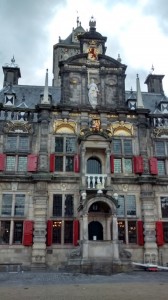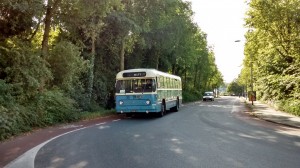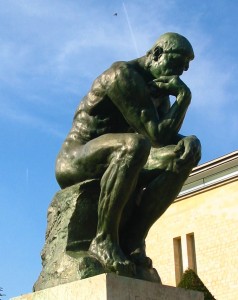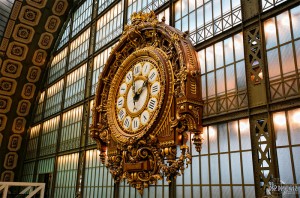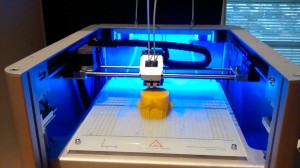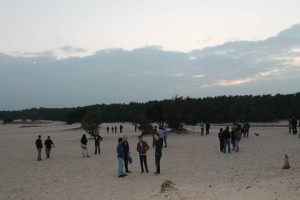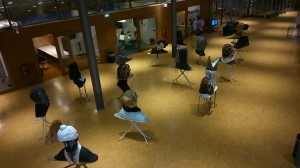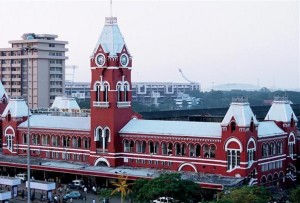Posted in 2014
A walk about Paris…
“A walk about Paris will provide lessons in history, beauty, and in the point of Life.”
-Thomas Jefferson
During my initial days in Delft, I decided to explore the city and trace its history. I found that on the second weekend of September every year, most tourist places in the Netherlands are open for free. This is called Monumentendag and this year it was on 13th and 14th September.
During Monumentendag, I visited all the places (except Museum Princenhof and Vanmeer Museum) that I could think of. I took a boat ride on the canals of Delft, visited Molen de Roos and also got a chance to go inside Stadhuis (City Hall). The most treasured visit was to a house where paintings made 500 years ago (estimated) on the ceiling were discovered recently. The weekend was wrapped up by a ride on an old bus which used to ply on the roads more than 30 years ago. I had visited Museum Princenhof in August and felt it is a wonderful museum. The story of Willem Orange was presented in chronological order in a very interactive manner.
In early November, after my quarter 1 exams, I had one week before quarter 2 began. I visited a friend of mine in Paris. I stayed 3 days at his place and went around Paris. Though Tour Eiffel and Musee Louvre are the most famous places in Paris, Musee Rodin and Musee d’Orsay stood out for me. The works of August Rodin, especially the Gate of Hell and the Thinker (which is a part of the Gate of Hell), are marvelous. One could observe them for hours and still miss out on details. Van Gogh’s Starry Night over the Rhone was the highlight of the visit to Musee d’Orsay. The manner in which Van Gogh captured the colours of the night is amazing.
Musee Curie was a small and informative museum about the Curie family and their works. Notre Dame Cathedral with its impressive yet asymmetric architecture was worth a visit. I wrapped my Paris trip with a sumptuous French dinner. I must say that the best thing about Paris is that all places of interest can be visited by foot. The beauty of the city lies in observing the small things that remind you of the good and the bad of the past. Not many talk about the Algiers memorial which is very close to the Tour Eiffel. It is not by accident that there are no modern skyscrapers within the city limits of Paris. Finally a visit to Paris cannot end without a mention of Art Nouveau architecture.
Fallen leaves lying on the grass…
“Fallen leaves lying on the grass in the November sun bring more happiness than the daffodils”
– Cyril Connolly
In November, quarter 2 began and I enrolled in two courses in addition to the two (Pattern Recognition and Seminar Advanced Digital Image Processing) that I am continuing. The first is Filtering and system Identification. This course is compulsory for me as well as many tracks in the Mechanical department. The second is Information Theory. Information theory is such a vast area of study and there are still many concepts which are hard to understand.
Filtering and Identification course is the largest course (in terms of the number of students enrolled) that I have taken. During the initial lectures, there were more than 150 students (rough estimate) attending the lectures. This was also the first course I attended that had its lecture videos recorded and made available on collegerama. This is probably the reason that as we entered into December the population shrunk to one-third. The course structure certainly is interesting and engaging. The final grade is split up into different tasks. 6% of the grade depends on the 4 homework assignments, 4% on the 2 Matlab exercises, 20% on the project and 70% on the written exam (open book). With 6 ECTS, this course certainly requires a lot of time on my part to understand the concepts well.
Information Theory course is theoretical (as the name says) and most of the concepts cannot be applied to real life situation without alteration. It is a 4 ECTS course and students are allowed to carry a double-sided A4 sheet with formulas to the exam. In the Pattern Recognition course, we began our handwritten digits recognition project in which we made an educated guess of selecting 13 classifiers and testing them for the conditions given before deciding on one classifier which satisfied the requirements of the project. In the Image processing course, I was given Image Segmentation project which requires me to implement a segmentation algorithm based on the paper http://www.cs.berkeley.edu/~malik/papers/arbelaezMFM-pami2010.pdf.
3D-Print Expo is taking place in the hall of the library from November 24 till January 19. The exhibition was created for the 3D print week which lasted till November 28. You can find photos in the following link. https://www.flickr.com/photos/tudelftlibrary/sets/72157649055609748/
Life is one big transition
“Life is one big transition.”
-Willie Stargell
When I arrived in the Netherlands, there were few new experiences that I was expecting. But, knowing is different from the true experience. First up is the weather. The transition from a place where the temperature hardly ever drops below 25°C to a place where the temperature hardly ever goes as high as the same temperature was seamless. I do need to wear an extra layer of clothing though.
The University gave the international students a warm welcome in the Introduction week where many intercultural activities were planned. I must admit that it was an enriching experience to know people from different parts of the world. I would have preferred if the Dutch students were also part of the Introduction week. The introduction week was followed by the Master kick-off to Soest organized by the faculty of EEMCS. The three-day programme was filled with introduction lectures and other interactive activities. For me the visit to Soestduinen was the highlight.
The beginning of lectures in Quarter 1 was my first experience in a Quarter system. My undergraduate programme had a Semester system, so this was a new experience. I enrolled in two compulsory (Statistical Digital Signal Processing and Pattern Recognition) and two specialization (Security and Cryptography and Seminar Advanced Image Processing) courses. Statistical Signal Processing course was intense and required regular study on my part to understand the topics covered. Pattern Recognition course is spread over two quarters and has a laboratory session which accompanies the two-hour lecture session. At the end of the course we will do a project on handwritten number recognition. Advanced Digital Image Processing is also spread over two quarters. The first quarter introduced many Image Processing techniques and in the second quarter we need do a project wherein we implement one of the techniques. Security and Cryptography was the most interesting course of the quarter. It initially covered the basic Cryptography topics and mechanisms before introducing advanced topics and present day applications.
The most important aspect of my learning curve has been the manner in which the Professors present themselves and the lack-of-ego in their behaviour. They value theirs as well as the students’ time. This is best exemplified by a story that a friend of mine, who is currently doing his PhD here, told me. When he was working on his Master thesis in his home country, his supervisor would command him to meet him at moment’s notice, even if he was in a different city, miles away. As a punishment, he will be humiliated by the Professor in front of his colleagues. On the contrary, his PhD supervisor sends him an email asking him what time will be convenient for him to meet.
When I arrived in August, the library had a sculpture exhibition of Eveline van Duyl’s work ‘Islands of thought’. From late September till early November, TE[CH]X(T)ILES exhibition was on in the library. These exhibitions, especially the TE[CH]X(T)ILES exhibition, give me an opportunity to think about new things which I might have done otherwise. Apart from the exhibitions, library is also the place where I join VOX discussions every Monday night. We have weekly discussion on different topics. Here is a link to the facebook page. https://www.facebook.com/groups/voxdelft/.
Hello! Namaste! Hallo!
I am Kris Shrishak, a thinker, an explorer, an engineer, a movie enthusiast, a quizzer and a lot more. I am currently pursuing my Masters in Electrical Engineering (Signals and Systems track) at the Delft University of Technology. I will be posting blogs about my master programme, the courses and in general my time in Delft.
So who am I? I grew up in Chennai (earlier known as Madras), a temple city on the eastern coast of southern India. Here is the location (http://tinyurl.com/mbhdbmq) if you haven’t heard of the place. As a child I grew up playing cricket (the most followed sport in India) and reading a number of books. Books have been my companions for life. Over the past few years my interest in cinema has grown leaps and bounds. Having watched “entertainment” oriented movies in my childhood, movies of Ingmar Bergman and Frederico Fellini changed my outlook towards cinema. I realized there is more to cinema than just “entertainment”.
Before leaving for the Netherlands, I was told that the Dutch are very straight forward and it is possible that I might find them to be rude. With this at the back of my mind, I entered the Netherlands only to be overwhelmed by the friendly nature of my Dutch buddies. I can’t recollect from my past if any stranger has gone an extra mile (literally) to help me with the directions to a new place. But it happens in Delft. With practically no knowledge of Dutch (except Hallo), I have had no issues in communicating with locals and that says a lot about hospitality.
I will keep you posted with my life in Delft. I hope you enjoy reading my blog.



